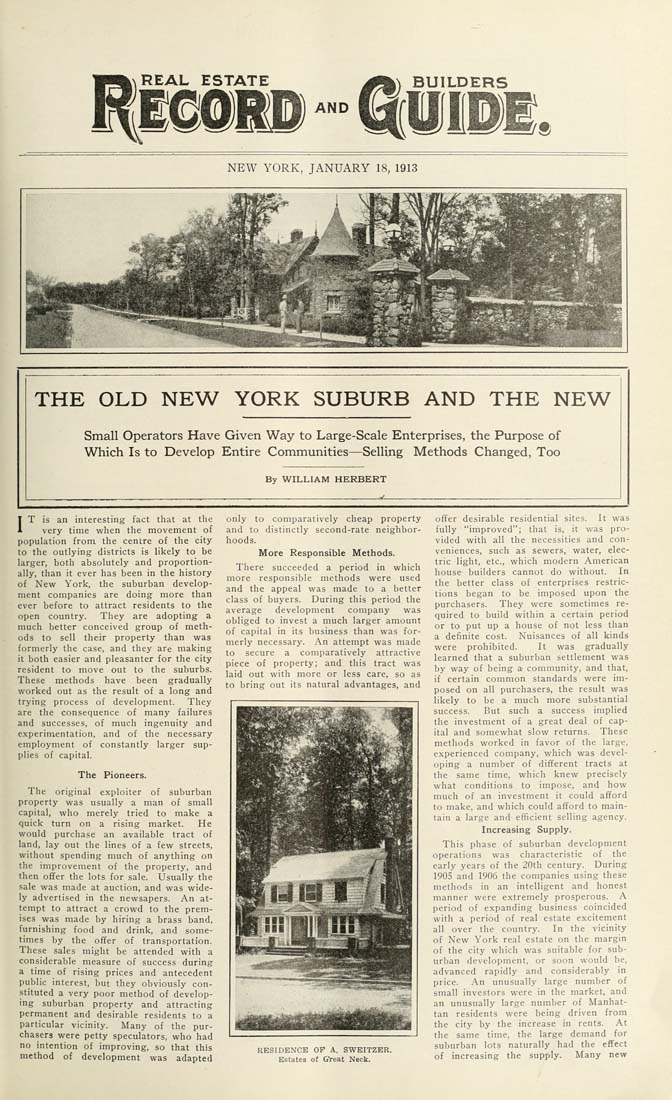Columbia University Libraries Digital Collections: The Real Estate Record
Use your browser's Print function to print these pages.
Real estate record and builders' guide: [v. 91, no. 2340]: January 18, 1913

Text version:
Please note: this text may be incomplete. For more information about this OCR, view About OCR text.
AND NEW YORK, JANUARY 18, 1913 THE OLD NEW YORK SUBURB AND THE NEW Small Operators Have Given Way to Large-Scale Enterprises, the Purpose of Which Is to Develop Entire Communities—Selling Methods Changed, Too By WILLIAM HERBERT IT is an interesting fact that at the very time when the movement of population from, the centre of the city to the outlying districts is likely to be larger, both absolutely and proportion¬ ally, than it ever has been in the history of New York, the suburban develop¬ ment companies are doing more than ever before to attract residents to the open country. They are adopting a much better conceived group of meth¬ ods to sell their property than was formerly the case, and they are making it both easier and pleasanter for the city resident to move out to the suburbs. These methods have been gradually worked out as the result of a long and trying process of development. They are the consequence of many failures and successes, of much ingenuity and experimentation, and of the necessary employment of constantly larger sup¬ plies of capital. The Pioneers. The original exploiter of suburban property was usually a man of small capital, who merely tried to make a quick turn on a rising market. He would purchase an available tract of land, lay out the lines of a few streets, without spending much of anything on the improvement of the property, and then ofTer the lots for sale. Usually the sale was made at auction, and was wide¬ ly advertised in the newsapers. An at¬ tempt to attract a crowd to the prem¬ ises was made by hiring a brass band, furnishing food and drink, and some¬ times by the ofifer of transportation. These sales might be attended with a considerable measure of success during a time of rising prices and antecedent public interest, but they obviously con¬ stituted a very poor method of develop¬ ing suburban property and attracting permanent and desirable residents to a particular vicinity. Many of the pur¬ chasers were petty speculators, who had no intention of improving, so that this method of development was adapted only to comparatively cheap property and to distinctly second-rate neighbor¬ hoods. More Responsible Methods. There succeeded a period in which more responsible methods were used and the appeal was made to a better class of buyers. During this period the average development company was obliged to invest a much larger amount of capital in its business than was for¬ merly necessary. An attempt was made to secure a comparatively attractive piece of property; and this tract was laid out with more or less care, so as to bring out its natural advantages, and RESIDENCE OP A. SWEITZER. Estates ot G"reat Neck. offer desirable residential sites. It was fully "improved"; that is, it was pro¬ vided with all the necessities and con¬ veniences, such as sewers, water, elec¬ tric light, etc., which modern American house builders cannot do without. In the better class of enterprises restric¬ tions began to be imposed upon the purchasers. They were sometimes re¬ quired to build within a certain period or to put up a house of not less than a definite cost. Nuisances of all kinds were prohibited. It was gradually learned that a suburban settlement was by way of being a community, and that, if certain common standards were im¬ posed on all purchasers, the result was likely to be a much more substantial success. But such a success implied the investment of a great deal of cap¬ ital and somewhat slow returns. These methods worked in favor of the large, experienced company, which was devel¬ oping a number of different tracts at the same time, which knew precisely what conditions to impose, and how much of an investment it could afford to make, and which could afford to main¬ tain a large and efficient selling agency. Increasing Supply. This phase of suburban development operations was characteristic of the early years of the 20th century. During 1905 and 1906 the companies using these methods in an intelligent and honest manner were extremely prosperous. A period of expanding business coincided with a period of real estate excitement all over the country. In the vicinity of New York real estate on the margin of the city which was suitable for sub¬ urban development, or soon would be, advanced rapidly and considerably in price. An unusually large number of small investors were in the market, and an unusually large number of Manhat¬ tan residents were being driven from the city by the increase in rents. At the same time, the large demand for suburban lots naturally had the effect of increasing the supply. Many new